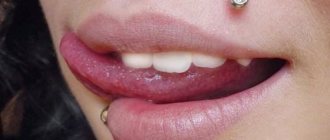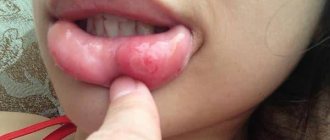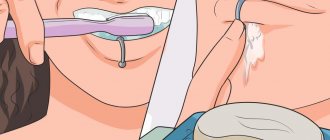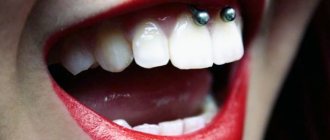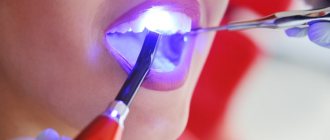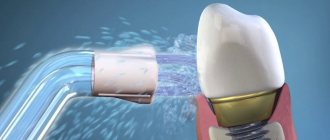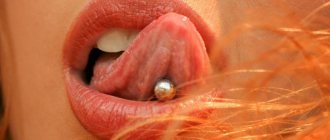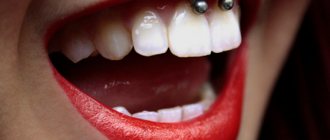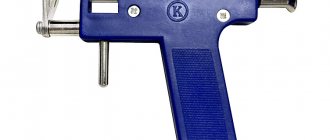Jellyfish piercing is one of the most popular types of decorative piercings on the face. The hole and decoration are installed in the hollow between the upper lip and the nasal septum. Typically, titanium, steel, Teflon, and, less commonly, silver or gold labrets, in which only a ball is visible in the cavity, are used as decoration. It looks very attractive and, as a rule, “jellyfish” is made by young girls who want to attract the attention of the opposite sex to their beautiful plump lips (as in the photo). Often, in parallel with the jellyfish, a piercing of the lower lip is made, in which a labret with a decorative ball is placed in the cavity between the chin and lower lip. Symmetrical decorations look impressive.
How is an upper lip piercing done?
This is a fairly simple procedure that takes no more than 10-15 minutes. It is advisable to carry out this manipulation in a specialized cosmetology salon, where sanitary requirements are carefully observed and sterile instruments are used. The procedure uses a medium-thick needle with a catheter, which allows you to easily and painlessly insert the jewelry.
Because the area above the upper lip is a fairly sensitive area, endowed with many nerve endings. A puncture in this area can be quite painful, so before the procedure, the specialist usually suggests using lidocaine as a local anesthetic.
The procedure itself consists of the following steps:
- the specialist marks a point above the lip with a special felt-tip pen;
- the skin is disinfected with an anesthetic;
- Using a special clamp with a hole, the master clamps and pulls back the upper lip;
- using a needle with a catheter, perforation of the skin and soft tissues is made through;
- a decoration is inserted through the catheter, a ball is screwed onto the surface above the lip;
- the puncture area is re-treated with a disinfectant.
After manipulation, it is necessary to monitor hygiene, adhere to a certain diet and regularly treat the skin and oral cavity to prevent infection.
Types of punctures
The types of lip piercings are classified according to the puncture site and the jewelry used.
Labret piercing
The most common type of piercing is under the lip. If you rely on the translation (from the Latin “labrum” means “lips”), then any lip piercing can be called a labret, but in narrow circles it is customary to call this only a piercing in the middle under the lip. This name is associated with the decoration used. A labret is a barbell with balls at the ends. There are wearing options when only one ball is visible or two at once. There are two types of this puncture - horizontal and vertical.
When vertical, the needle passes in one place, usually perpendicular to the lip, in the middle. The vertical labret has variations - you can make a puncture directly through the lower lip, then the two ends of the decoration will always be visible, or you can remove the needle from the inside of the lip, then only one ball will remain outside. This type of piercing is also called “estrum”. A horizontal labret can also be made in the lip or under it. The horizontal view is more problematic, because It is very difficult to overcome the desire to lick your lips, and therefore saliva gets into the not yet healed puncture, which carries a lot of bacteria with it.
Frenum piercing
The frenulum piercing is one of the easiest and quickest to heal. Usually the frenulum of the upper lip is pierced; this piercing is also called “smile”, because others will be able to see it only if you smile. A piercing of the lower frenulum is a symbol of sullenness; in everyday life it is called “anti-smile”. Frenulum piercing involves wearing various jewelry - you can wear a ring, horseshoe, banana, etc.
Monroe puncture
This puncture is made above the upper lip on the side of the middle; it looks like a mole. This type of lip piercing is also called “Madonna” or “Crawford” after the names of famous women who had an attractive mole above their lip. However, there is one difference between them: “Monroe” is done on the left side, and “Madonna” and “Crawford” are done on the right. You can also make two symmetrical piercings on the side, this type of lip piercing is called a dahlia.
Due to the fact that the skin on this area of the face is quite thin and there are quite a few nerve endings, this type of lip piercing is far from the most painful. However, you need to take into account the characteristics of your body, because all people have different pain thresholds.
It is worth knowing that “Monroe” does not suit all people. It will look most impressive on girls with black or red hair and is not at all suitable for those with freckles and long eyes.
Jellyfish piercing
The founder of this type of lip piercing is a Canadian hairdresser, who was the first to try such a piercing. “Medusa” is a type of “labret”, only this piercing is done not under the lip, but in a notch above the upper one.
In addition to the main types of lip piercings, there are combined options:
- "Snake bite". To get such a piercing, a puncture is made under the lip on both sides, symmetrically relative to the middle.
- "Angel Bite" This type of piercing is a combination of Monroe and Madonna. Two symmetrical punctures are made above the upper lip.
- "Spider bite." The lower lip is pierced on one side twice, the punctures are located close to each other. Rings are used as decorations.
- "Shark bite." Same as a spider bite, but two punctures are made on different sides, for a total of four. Rings are also used.
Piercing Care
Healing takes different amounts of time for different people. If you follow the recommendations for caring for the puncture, it will heal in 1.5-2 weeks; for some people the process takes about a month. To do this, you need to follow simple recommendations:
- four days after piercing, it is necessary to avoid contact with water, so it is advisable to avoid washing and showering, and clean your face with a cotton pad with milk or other cosmetic product;
- during the healing period (1-2 weeks), it is recommended to avoid sour, salty, too hot foods that can cause irritation;
- to prevent organic particles from getting into the wound, it is advisable to rinse your mouth after each meal;
- the puncture area must be treated with an antiseptic solution without alcohol, in parallel with it it is allowed to use wound healing agents with vitamin B or E;
- It is advisable not to touch the jewelry with unwashed hands, do not rub your nose, and in case of a runny nose, use drying drops to prevent excessive mucus secretion;
- the decoration does not need to be scrolled, removed and changed until a channel is formed.
Possible complications
As with other types of piercings, the most common type of complication for the jellyfish is infection. Bacteria can enter the tissue either during the procedure (for example, if the specialist does not sterilize the instrument thoroughly enough) or during the healing period.
A specific type of complication from a jellyfish piercing is damage to the tooth enamel and gums above the upper front teeth. A metal object that is constantly in contact with the teeth leads to the appearance of microscopic cracks in which anaerobic bacteria accumulate, causing caries. Like other types of oral piercings, jellyfish can lead to loose teeth and other negative consequences that dentists warn about.
Contraindications
As with other types of piercing, the “jellyfish” has the following contraindications:
- acute diseases accompanied by high body temperature and fever;
- oncological diseases;
- allergy to anesthetics (if used, they can cause anaphylactic shock);
- problems with blood clotting, tendency to bleed, taking anticoagulants (aspirin, etc.);
- violations of the integrity of the skin, scratches, rashes in the area of the intended puncture;
- infectious diseases (including hepatitis B and C, HIV).
Girls are not recommended to get piercings during menstruation or pregnancy. At this time, significant changes in hormonal levels occur, due to which blood clotting decreases, as well as vulnerability to infections.
Painfulness of the procedure
Any piercing is accompanied by unpleasant sensations, and jellyfish piercings on the upper and lower lips are no exception.
The level of pain depends on the following factors:
- pain threshold;
- presence or absence of anesthesia;
- master level;
- condition at the time of piercing (it is undesirable to do piercing during illness).
It is not recommended to come to a session after a sleepless night, hungry or showing signs of illness. These symptoms will increase the likelihood of pain during the process.
In the photo - a variant of the jellyfish piercing - jestrum (estrum) piercing:
How to choose jewelry?
All modern types of piercing are performed using safe metals and alloys that do not oxidize upon contact with air and do not cause rejection upon contact with body tissue. These include:
- medical steel;
- titanium;
- Teflon;
- zirconium.
Silver and gold are not recommended, especially immediately after a piercing, because... they can cause suppuration and abscess. After the puncture area has healed and a channel has been formed, more complex jewelry can be inserted - with crystals, rhinestones, flowers, beads. If the jewelry changes color (most often silver darkens), it is advisable to replace it with something else by contacting an experienced piercer.
Where to get a piercing?
The best option is a specialized salon, staffed by qualified craftsmen who have access to certified equipment. The key requirement is compliance with the rules of sterilization of instruments and maintaining the necessary sanitary and hygienic environment. The client has every right to make sure that the instruments are sterile without fear of offending the specialist. If you have the slightest doubt, it is better to go to another salon.
The master must comply with the following requirements:
- use clean cotton pads to apply the anesthetic, or use the product in spray form;
- use only sterile needles, unpack them in the presence of the client so that he can see;
- store instruments in a sterile area (under a UV lamp);
- work in disposable latex or rubber gloves, take new ones from the packaging for each client.
If these requirements are met, the risk of tissue infection during the procedure is minimal. Otherwise, bacteria may enter the wound and an infection may develop. Its symptoms:
- increased pain in the puncture area;
- swelling and swelling of the upper lip;
- discharge of pus;
- tissue compaction at the puncture site;
- increased body temperature;
- symptoms of intoxication - weakness, headache.
In this case, it is recommended to urgently consult a doctor - surgeon, cosmetologist, dermatologist. He must examine the area above the upper lip, if necessary, remove the jewelry, clean the wound, remove pus and disinfect the tissue. The doctor may prescribe local antibacterial agents or oral antibiotics. In this case, the decoration will have to be thrown away or replaced with something else.
Features of the operation
Jellyfish piercing is one of the most beautiful types of such aesthetic surgeries. Due to the absence of nerve endings in the philtrum, this body modification is the most comfortable and painless. There are also no blood vessels or large capillaries, so there will be no blood. However, you should entrust the execution only to an experienced and careful craftsman with high qualifications.
The choice of place for piercing always depends on aesthetics; the decoration should look attractive and harmonious in a certain position. This is the area in the middle of the upper lip, which passes into the nasal philtrum. Sometimes a puncture is made under the lower lip, but it is painful and more difficult to perform, so it is not so popular in salons.
The manipulation itself requires no more than 5 minutes:
- the master disinfects the future puncture area;
- marking is carried out;
- the point of needle penetration is agreed upon with the client;
- if a person has a low pain threshold, then local anesthesia is given;
- The working area is fixed with special tools;
- a through hole is made;
- the earring is threaded through;
- the wound is treated with chlorhexidine.
Please note that during piercing, watery discharge, bloody streaks, and aching pain are possible. This phenomenon is considered normal and is not a deviation.
